Effects of Sand/Fly Ash and the Water/Solid Ratio on the Mechanical Properties of Engineered Geopolymer Composite and Mix Design Optimization
Abstract
1. Introduction
Research Significance
2. Experimental Program
2.1. Material Properties
2.2. Response Surface Method (RSM) Application for Experiment Design
2.3. Mixing and Casting of Samples
2.4. Experimental and Test Procedures
3. Results and Discussion
3.1. Effect of S/FA and W/GP Solids on the Slump-Flow (Workability) of EGC
3.2. Effect of W/GP Solids and S/FA on the Compressive Strength of EGC
3.3. Effect of W/GP Solids and Sand/fly Ash on the Modulus of Elasticity of EGC
3.4. Flexural Properties
3.4.1. Effect of W/GP Solids and S/FA on Flexural Strength of EGC
3.4.2. Effect of W/GP Solids and S/FA on Flexural Toughness of EGC
3.4.3. Effect of W/GP Solids and S/FA on Ductility Index of EGC
3.4.4. Effect of W/GP solids and S/FA on drying shrinkage of EGC
3.5. Validation of ANOVA Models
3.6. Optimization
Experimental Validation Study
4. Conclusions
Author Contributions
Funding
Acknowledgments
Conflicts of Interest
References
- Wang, J.; Wang, Y.; Sun, Y.; Tingley, D.D.; Zhang, Y. Life cycle sustainability assessment of fly ash concrete structures. Renew. Sustain. Energy Rev. 2017, 80, 1162–1174. [Google Scholar] [CrossRef]
- McLellan, B.C.; Williams, R.P.; Lay, J.; Van Riessen, A.; Corder, G.D. Costs and carbon emissions for geopolymer pastes in comparison to ordinary portland cement. J. Clean. Prod. 2011, 19, 1080–1090. [Google Scholar] [CrossRef]
- Zahid, M.; Shafiq, N.; Jalal, A. Investigating the effects of solarcure curing method on the compressive strength, microstructure and polymeric reaction of fly ash based geopolymer. Constr. Build. Mater. 2018, 181, 227–237. [Google Scholar] [CrossRef]
- Yu, X.; Chen, L.; Komarneni, S.; Hui, C. Fly ash-based geopolymer: Clean production in, properties and applications. J. Clean. Prod. 2016, 125, 253–267. [Google Scholar] [CrossRef]
- Zahid, M.; Shafiq, N.; Nuruddin, M.F.; Nikbakht, E.; Jalal, A. Effect of Partial Replacement of Fly Ash by Metakaolin on Strength Development of Fly Ash Based Geopolymer Mortar; Key Engineering Materials; Trans Tech Publications: Kapellweg, Switzerland, 2017; pp. 131–135. [Google Scholar] [CrossRef]
- Davidovits, J. Geopolymers: Inorganic polymeric new materials. J. Therm. Anal. 1991, 37, 1633–1656. [Google Scholar] [CrossRef]
- Tasdemir, C.; Tasdemir, M.A.; Lydon, F.D.; Barr, B.I.G. Effects of silica fume and aggregate size on the brittleness of concrete. Cem. Concr. Res. 1996, 26, 63–68. [Google Scholar] [CrossRef]
- Nematollahi, B.; Qiu, J.; Yang, E.H.; Sanjayan, J. Micromechanics constitutive modeling and optimization of strain hardening geopolymer composite. Ceram. Int. 2017, 43, 5999–6007. [Google Scholar] [CrossRef]
- Jalal, A.; Shafiq, N.; Nikbakht, E.; Kumar, R.; Zahid, M. Mechanical Properties of Hybrid Basalt-Polyvinyl Alcohol (PVA) Fiber Reinforced Concrete. Key Eng. Mater. 2017, 744, 3–7. [Google Scholar] [CrossRef]
- Aslani, F.; Kelin, J. Assessment and development of high-performance fiber-reinforced lightweight self-compacting concrete, including recycled crumb rubber aggregates exposed to elevated temperatures. J. Clean. Prod. 2018, 200, 1009–1025. [Google Scholar] [CrossRef]
- Abbass, W.; Khan, M.I.; Mourad, S. Evaluation of mechanical properties of steel fiber reinforced concrete with different strengths of concrete. Constr. Build. Mater. 2018, 168, 556–569. [Google Scholar] [CrossRef]
- Kasagani, H.; Rao, C.B.K. Effect of graded fibers on stress-strain behavior of Glass Fiber Reinforced Concrete in tension. Constr. Build. Mater. 2018, 183, 592–604. [Google Scholar] [CrossRef]
- Branston, J.; Das, S.; Kenno, S.Y.; Taylor, C. Mechanical behavior of basalt fiber reinforced concrete. Constr. Build. Mater. 2016, 124, 878–886. [Google Scholar] [CrossRef]
- Noushini, A.; Samali, B.; Vessalas, K. Flexural toughness and ductility characteristics of polyvinyl-alcohol fiber reinforced concrete (PVA-FRC). In Proceedings of the 8th International Conference on Fracture Mechanics of Concrete and Concrete Structure, Toledo, Spain, 10–14 March 2013; pp. 1110–1121. [Google Scholar]
- Atiş, C.D.; Karahan, O. Properties of steel fiber reinforced fly ash concrete. Constr. Build. Mater. 2009, 23, 392–399. [Google Scholar] [CrossRef]
- Marcos-Meson, V.; Michel, A.; Solgaard, A.; Fischer, G.; Edvardsen, C.; Skovhus, T.L. Corrosion resistance of steel fiber reinforced concrete-A literature review. Cem. Concr. Res. 2018, 103, 1–20. [Google Scholar] [CrossRef]
- Hughes, B.P.; Fattuhi, N.I. The workability of steel-fiber-reinforced concrete. Mag. Concr. Res. 1976, 28, 157–161. [Google Scholar] [CrossRef]
- Horikoshi, T.; Ogawa, A.; Saito, T.; Hoshiro, H. Properties of Polyvinylalcohol fiber as reinforcing materials for cementitious composites. Int. Work. HPFRCC Struct. 2005, 2, 1–8. [Google Scholar]
- Choi, J.I.; Lee, B.Y. Bonding properties of basalt fiber and strength reduction according to fiber orientation. Materials 2015, 8, 6719–6727. [Google Scholar] [CrossRef]
- Zahid, M.; Shafiq, N.; Isa, M.H. Statistical modeling and mix design optimization of fly ash based engineered geopolymer composite using response surface methodology. Clean. Prod. 2018, 194. [Google Scholar] [CrossRef]
- Atahan, H.N.; Pekmezci, B.Y.; Tuncel, Y. Behavior of PVA Fiber Reinforced Cementitious Composites under Static and Impact Flexural Effects. J. Mater. Civ. Eng. 2012, 120922005613009. [Google Scholar] [CrossRef]
- Salih, A.F.M.; Shafiq, N.; Nuruddin, M.F.; Elheber, A.; Memon, F.A. Comparison of the effects of different fibers on the properties of self-compacting concrete. Res. J. Appl. Sci. Eng. Technol. 2014, 7, 3332–3341. [Google Scholar] [CrossRef]
- Fischer, G.; Li, V.C. Effect of fiber reinforcement on the response of structural members. Eng. Fract. Mech. 2007, 74, 258–272. [Google Scholar] [CrossRef]
- Pan, J.L.; Yuan, F.; Luo, M.; Leung, K.Y. Effect of composition on flexural behavior of engineered cementitious composites. Sci. China Technol. Sci. 2012, 55, 3425–3433. [Google Scholar] [CrossRef]
- Committee, J.-D. DFRCC Terminology and Application Concepts. J. Adv. Concr. Technol. 2003, 1, 335–340. [Google Scholar] [CrossRef]
- Li, V.C. Engineered Cementitious Composites (ECC)–Material, Structural, and Durability Performance in Concrete Construction Engineering; University of Michigan: Ann Arbor, MI, USA, 2007; pp. 373–381. [Google Scholar] [CrossRef]
- Ranjbar, N.; Mehrali, M.; Mehrali, M.; Alengaram, U.J.; Jumaat, M.Z. High tensile strength fly ash based geopolymer composite using copper coated micro steel fiber. Constr. Build. Mater. 2016, 112, 629–638. [Google Scholar] [CrossRef]
- Timakul, P.; Rattanaprasit, W.; Aungkavattana, P. Improving compressive strength of fly ash-based geopolymer composites by basalt fibers addition. Ceram. Int. 2016, 42, 6288–6295. [Google Scholar] [CrossRef]
- Vijai, K.; Kumutha, R.; Vishnuram, B.G. Properties of Glass Fibre Reinforced Geopolymer Concrete Composites. Asian J. Civ. Eng. Building Hous. 2012, 13, 511–520. [Google Scholar]
- Nematollahi, B.; Sanjayan, J.; Shaikh, F.U.A. Matrix design of strain hardening fiber reinforced engineered geopolymer composite. Compos. Part B Eng. 2015, 27, 253–265. [Google Scholar] [CrossRef]
- Ferdosian, I.; Camões, A. Eco-efficient ultra-high performance concrete development using response surface methodology. Cem. Concr. Compos. 2017, 84, 146–156. [Google Scholar] [CrossRef]
- Ekpenyong, M.G.; Antai, S.P.; Asitok, D.; Ekpo, B.O. Plackett-Burman Design and Response Surface Optimization of Medium Trace Nutrients for Glycolipopeptide Biosurfactant Production. Iran. Biomed. J. 2017, 21, 249–260. [Google Scholar] [CrossRef]
- Mohajeri, L.; Aziz, H.A.; Isa, M.H.; Zahed, M.A. A statistical experiment design approach for optimizing biodegradation of weathered crude oil in coastal sediments. Bioresour. Technol. 2010, 101, 893–900. [Google Scholar] [CrossRef]
- Eriksson, L.; Johansson, E.; Wikström, C. Mixture design-Design generation, PLS analysis, and model usage. Chemom. Intell. Lab. Syst. 1998, 43, 1–24. [Google Scholar] [CrossRef]
- Khotbehsara, M.M.; Mohseni, E.; Yazdi, M.A.; Sarker, P.; Ranjbar, M.M. Effect of nano-CuO and fly ash on the properties of self-compacting mortar. Constr. Build. Mater. 2015, 94, 758–766. [Google Scholar] [CrossRef]
- Ghafari, E.; Costa, H.; Júlio, E. RSM-based model to predict the performance of self-compacting UHPC reinforced with hybrid steel micro-fiber. Constr. Build Mater. 2014, 66, 375–383. [Google Scholar] [CrossRef]
- Bayramov, F.; Taşdemir, C.; Taşdemir, M.A. Optimization of steel fiber reinforced concretes employing statistical response surface method. Cem. Concr. Compos. 2004, 26, 665–675. [Google Scholar] [CrossRef]
- Al-Alaily, H.S.; Hassan, A.A.A. Refined statistical modeling for chloride permeability and strength of concrete containing metakaolin. Constr. Build. Mater. 2016, 114, 564–579. [Google Scholar] [CrossRef]
- Mermerdaş, K.; Algın, Z.; Oleiwi, S.M.; Nassani, D.E. Optimization of lightweight GGBFS and FA geopolymer mortars by response surface method. Constr. Build. Mater. 2017, 139, 159–171. [Google Scholar] [CrossRef]
- Shafiq, N.; Nuruddin, M.N.; Kamaruddin, I. Comparison of engineering and durability properties of fly ash blended cement concrete made in UK and Malaysia. Adv. Appl. Ceram. 2007, 106, 314–318. [Google Scholar] [CrossRef]
- Nematollahi, B.; Sanjayan, J.; Shaikh, F.U.A. Comparative deflection hardening behavior of short fiber reinforced geopolymer composites. Constr. Build. Mater. 2014, 70, 54–64. [Google Scholar] [CrossRef]
- Del Coz Diaz, J.J.; Garcia-Nieto, P.J.; Alvarez-Rabanall, F.P.; Alonso-Martínez, M.; Dominguez-Hernandez, J.; Perez-Bella, J.M. The use of response surface methodology to improve the thermal transmittance of lightweight concrete hollow bricks by FEM. Constr. Build. Mater. 2014, 52, 331–344. [Google Scholar] [CrossRef]
- Mohajeri, S.; Aziz, H.A.; Isa, M.H.; Zahed, M.A.; Adlan, M.N. Statistical optimization of process parameters for landfill leachate treatment using electro-Fenton technique. J. Hazard. Mater. 2010, 176, 749–758. [Google Scholar] [CrossRef]
- ASTM C1437. Standard Test Method for Flow of Hydraulic Cement Mortar. ASTM Int. 2016, 1–2. [Google Scholar] [CrossRef]
- Li, M.; Li, V.C. Rheology, fiber dispersion, and robust properties of Engineered Cementitious Composites. Mater. Struct. 2013, 46, 405–420. [Google Scholar] [CrossRef]
- ASTM C1609. Standard Test Method for Flexural Performance of Fiber-Reinforced Concrete (Using Beam With Third-Point Loading). ASTM 2012, 1–8. [CrossRef]
- Gao, Y.; Xu, J.; Luo, X.; Zhu, J.; Nie, L. Experiment research on mix design and early mechanical performance of alkali-activated slag using response surface methodology (RSM). Ceram. Int. 2016, 42, 11666–11673. [Google Scholar] [CrossRef]
- Mohammed, B.S.; Fang, O.C.; Anwar Hossain, K.M.; Lachemi, M. Mix proportioning of concrete containing paper mill residuals using response surface methodology. Constr. Build. Mater. 2012, 35, 63–68. [Google Scholar] [CrossRef]
- Chen, X.; Wu, S. Influence of water-to-cement ratio and curing period on pore structure of cement mortar. Constr. Build. Mater. 2013, 38, 804–812. [Google Scholar] [CrossRef]
- Chung, K.L.; Ghannam, M.; Zhang, C. Effect of Specimen Shapes on Compressive Strength of Engineered Cementitious Composites (ECCs) with Different Values of Water-to-Binder Ratio and PVA Fiber. Arab. J. Sci. Eng. 2018, 43, 1825–1837. [Google Scholar] [CrossRef]
- Güneyisi, E.; Gesoǧlu, M.; Algin, Z.; Mermerdaş, K. Optimization of concrete mixture with hybrid blends of metakaolin and fly ash using response surface method. Compos. Part B Eng. 2014, 60, 707–715. [Google Scholar] [CrossRef]
- Silva, R.V.; De Brito, J.; Dhir, R.K. Establishing a relationship between modulus of elasticity and compressive strength of recycled aggregate concrete. J. Clean. Prod. 2016, 112, 2171–2186. [Google Scholar] [CrossRef]
- Li, V.C.; Leung, C.K. Steady-state and multiple cracking of short random fiber composites. J. Eng. Mech. 1992, 118, 2246–2264. [Google Scholar] [CrossRef]
- Mohammed, B.S.; Achara, B.E.; Nuruddin, M.F.; Yaw, M.; Zulkefli, M.Z. Properties of nano-silica-modified self-compacting engineered cementitious composites. J. Clean. Prod. 2017, 162, 1225–1238. [Google Scholar] [CrossRef]
- Altwair, N.M.; Megat Johari, M.A.; Saiyid Hashim, S.F. Flexural performance of green engineered cementitious composites containing high volume of palm oil fuel ash. Constr. Build. Mater. 2012, 37, 518–525. [Google Scholar] [CrossRef]
- Maalej, M.; Li, V.C. Flexural/Tensile-Strength Ratio in Engineered Cementitious Composites. J. Mater. Civ. Eng. 1994, 6, 513–528. [Google Scholar] [CrossRef]
- Altwair, N.M.; Megat Johari, M.A.; Saiyid Hashim, S.F. Strength Activity Index and Microstructural Characteristics of Treated Palm Oil Fuel Ash. Int. J. Civ. Environ. Eng. 2011, 11, 100–107. [Google Scholar]
- Shaikh, F.U.A. Deflection hardening behavior of short fiber reinforced fly ash based geopolymer composites. Mater. Des. 2013, 50, 674–682. [Google Scholar] [CrossRef]
- Yang, Y.; Gao, X.; Deng, H.; Yu, P.; Yao, Y. Effects of water/binder ratio on the properties of engineered cementitious composites. J. Wuhan Univ. Technol. Mater. Sci. Ed. 2010, 25, 298–302. [Google Scholar] [CrossRef]
- Kanda, T.; Li, V.C. Interface Property and Apparent Strength of High-Strength Hydropidlic Fiber in Cement Matrix. J. Mater. Civ. Eng. 1998, 10, 5–13. [Google Scholar] [CrossRef]
- Li, V.C.; Wu, C.; Wang, S.; Ogawa, A.; Saito, T. Interface tailoring for strain-hardening polyvinyl alcohol-engineered cementitious composite (PVA-ECC). ACI Mater. J. 2002, 99, 463–472. [Google Scholar] [CrossRef]
- Wallah, S.E.; Rangan, B. Low-Calcium Fly Ash-Based Geopolymer Concrete: Long-Term Properties; Research Report; Curtin University: Perth, Australia, 2006. [Google Scholar]
- Minoru, K.; Keitetsu, R. Recent Progress on HPFRCC in Japan Required Performance and Applications. J. Adv. Concr. Technol. 2006, 4, 19–33. [Google Scholar] [CrossRef]
- Altwair, N.M.; Johari, M.A.M.; Hashim, S.F.S. Shrinkage Characteristics of Green Engineered Cementitious Composites with Varying Palm Oil Fuel Ash Contents and Water-Binder Ratios. Adv. Mater. Res. 2012, 626, 245–249. [Google Scholar] [CrossRef]
- Zhang, J.; Gong, C.; Guo, Z.; Zhang, M. Engineered cementitious composite with characteristic of low drying shrinkage. Cem. Concr. Res. 2009, 39, 303–312. [Google Scholar] [CrossRef]
- Subasi, A.; Sahin, B.; Kaymaz, I. Multi-objective optimization of a honeycomb heat sink using the Response Surface Method. Int. J. Heat Mass Transf. 2016, 101, 295–302. [Google Scholar] [CrossRef]
- Sivaraos Milkey, K.R.; Samsudin, A.R.; Dubey, A.K.; Kidd, P. Comparison between the Taguchi method and response surface methodology (RSM) modelingng CO2 laser machining. Jordan J. Mech. Ind. Eng. 2014, 8, 35–42. [Google Scholar] [CrossRef]
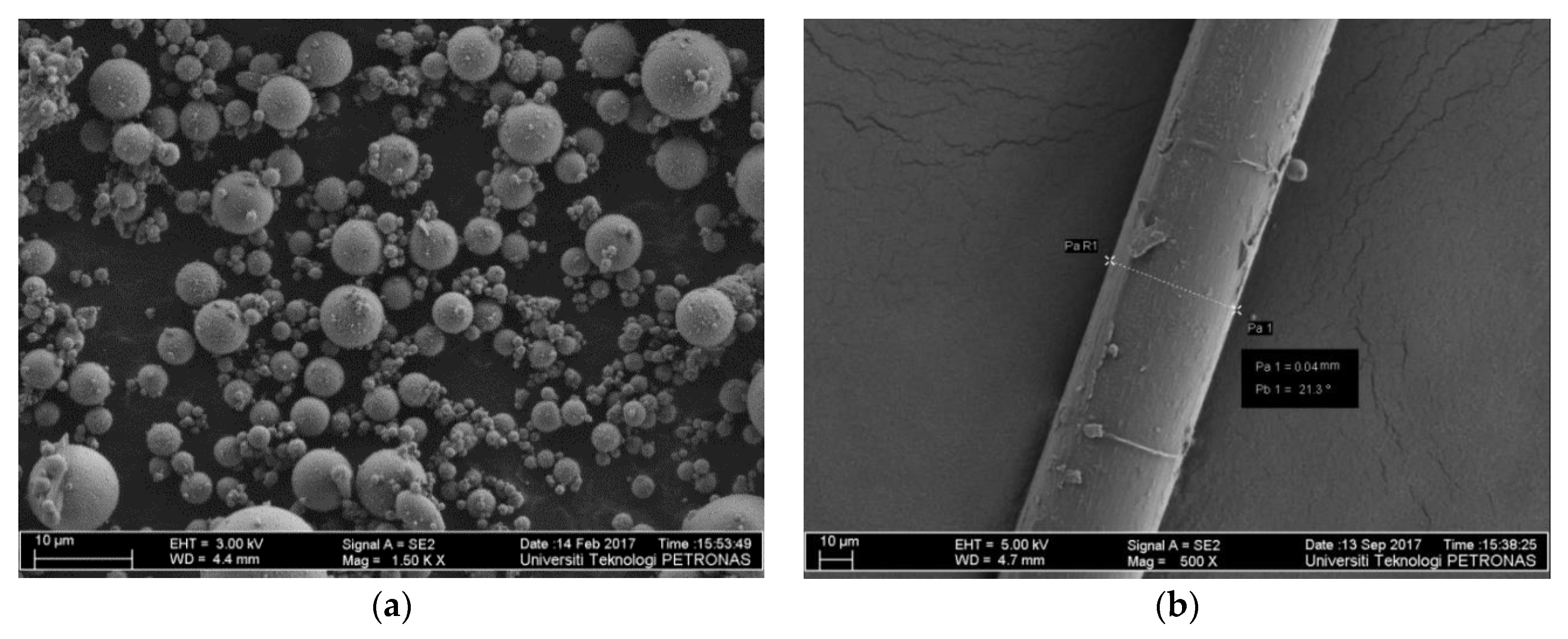

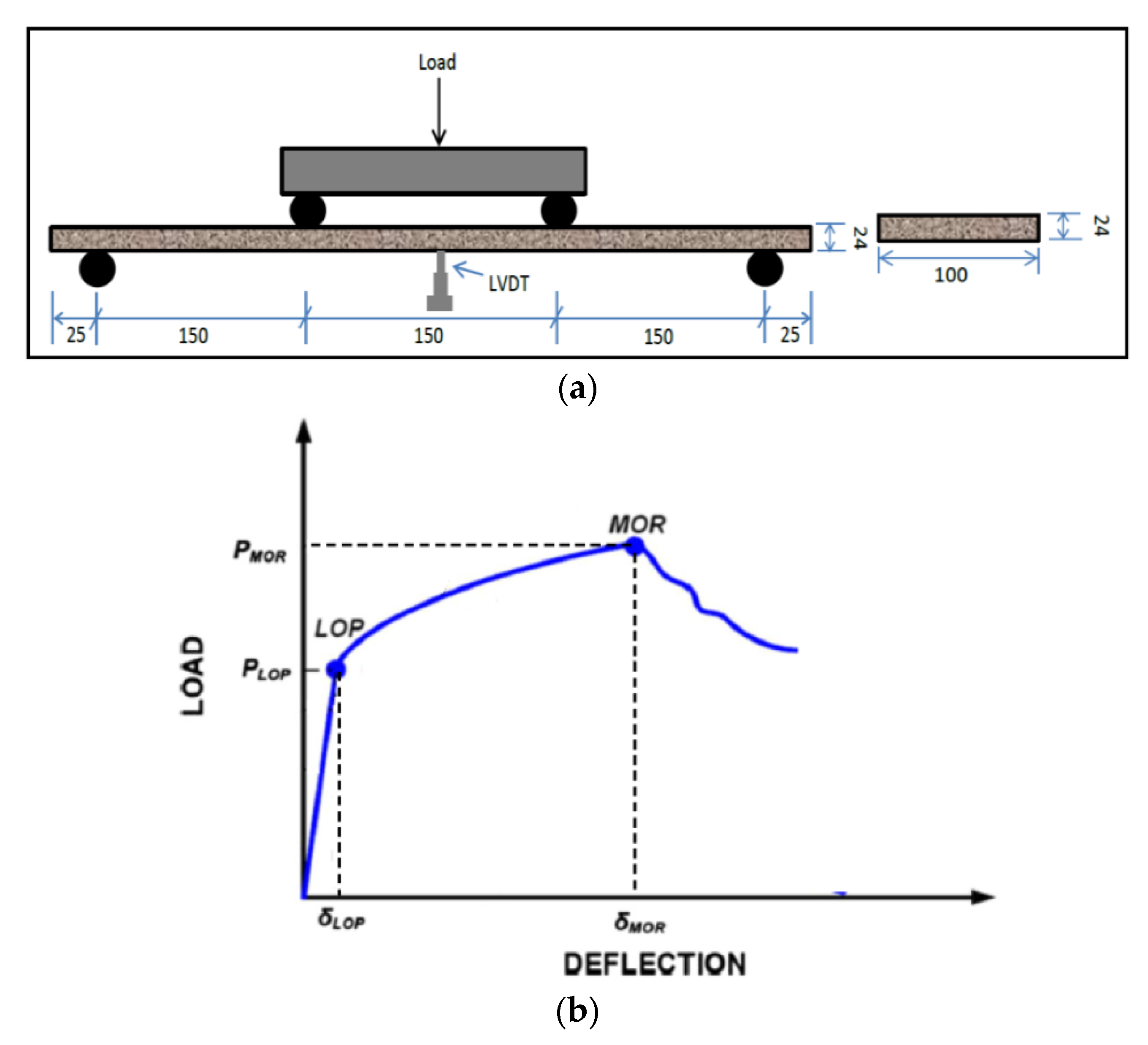
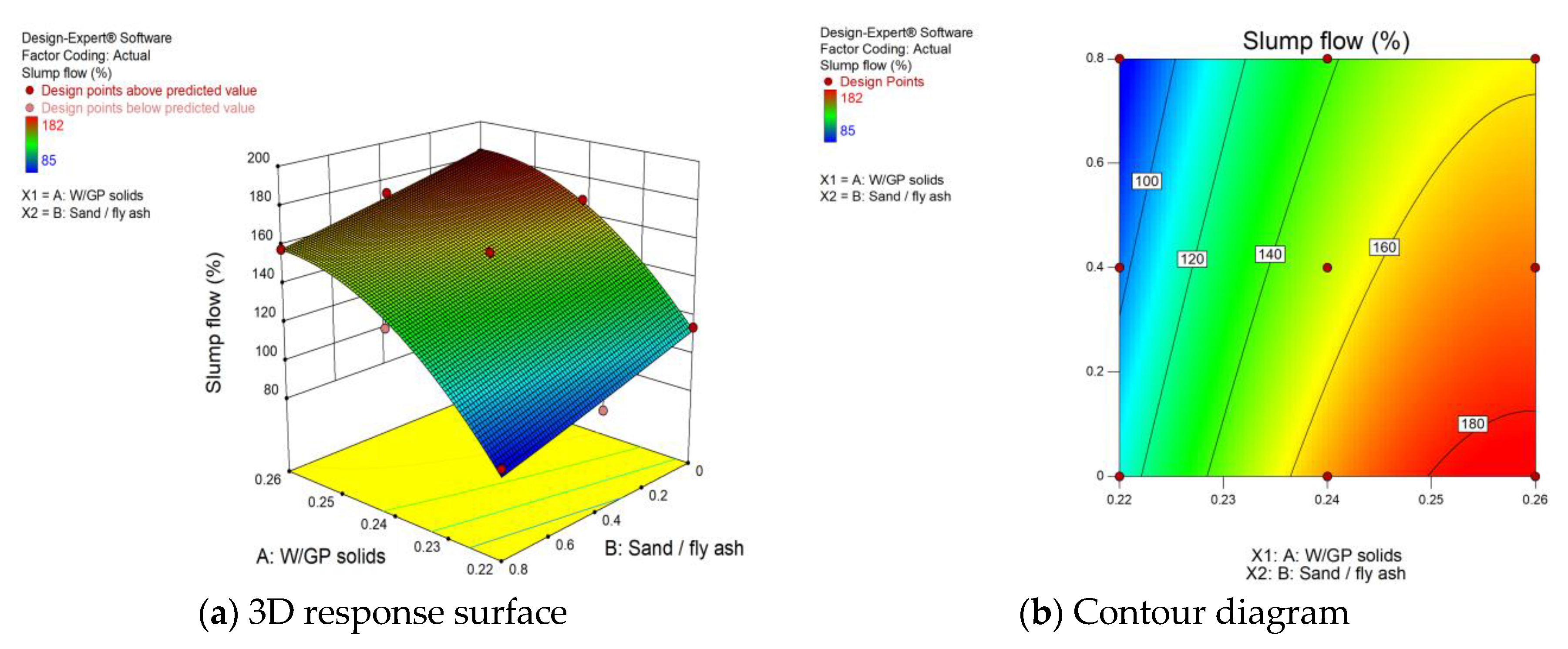
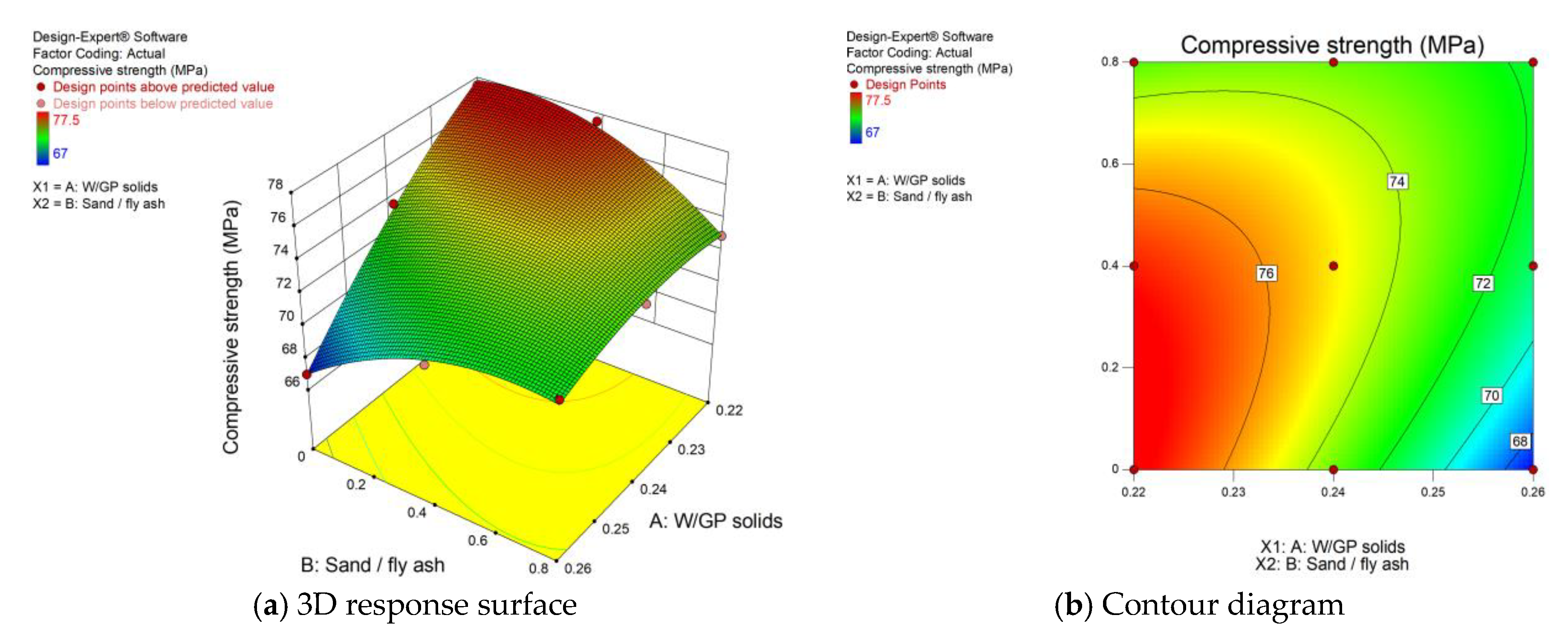
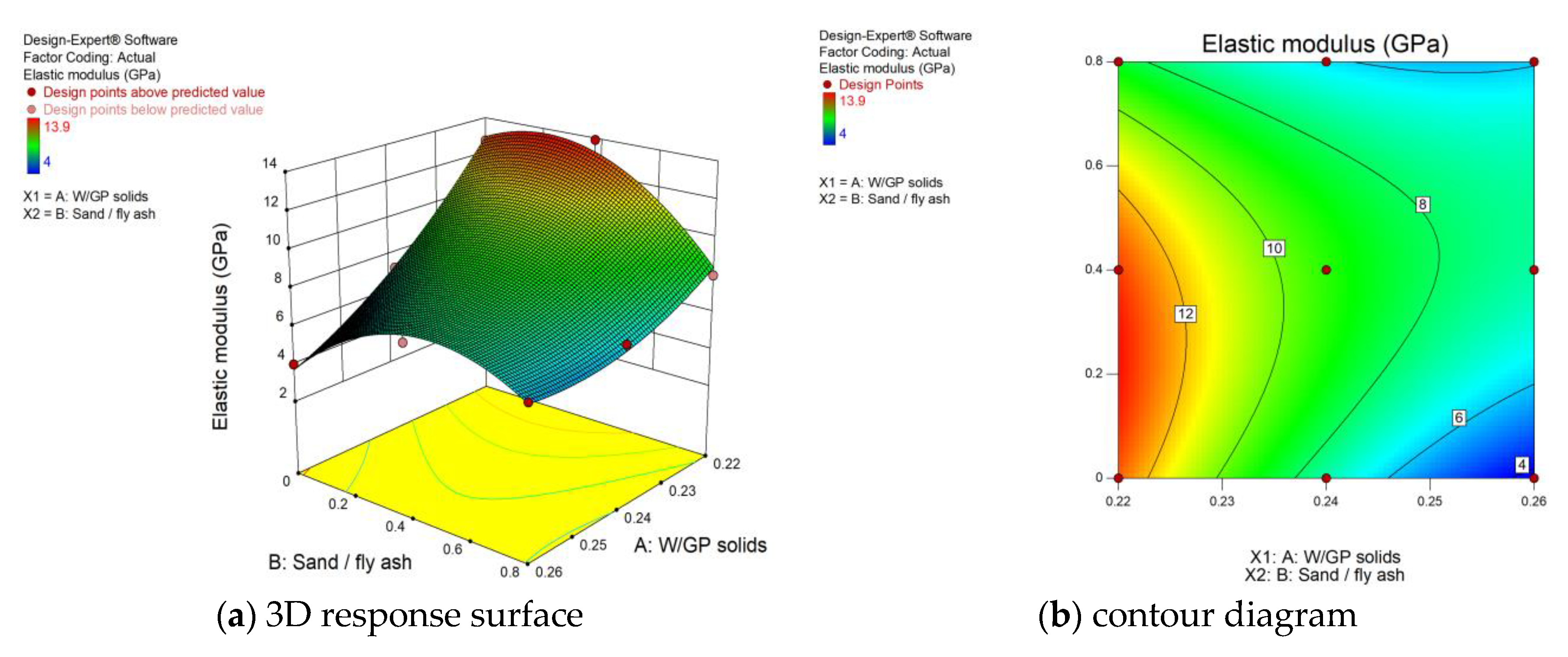
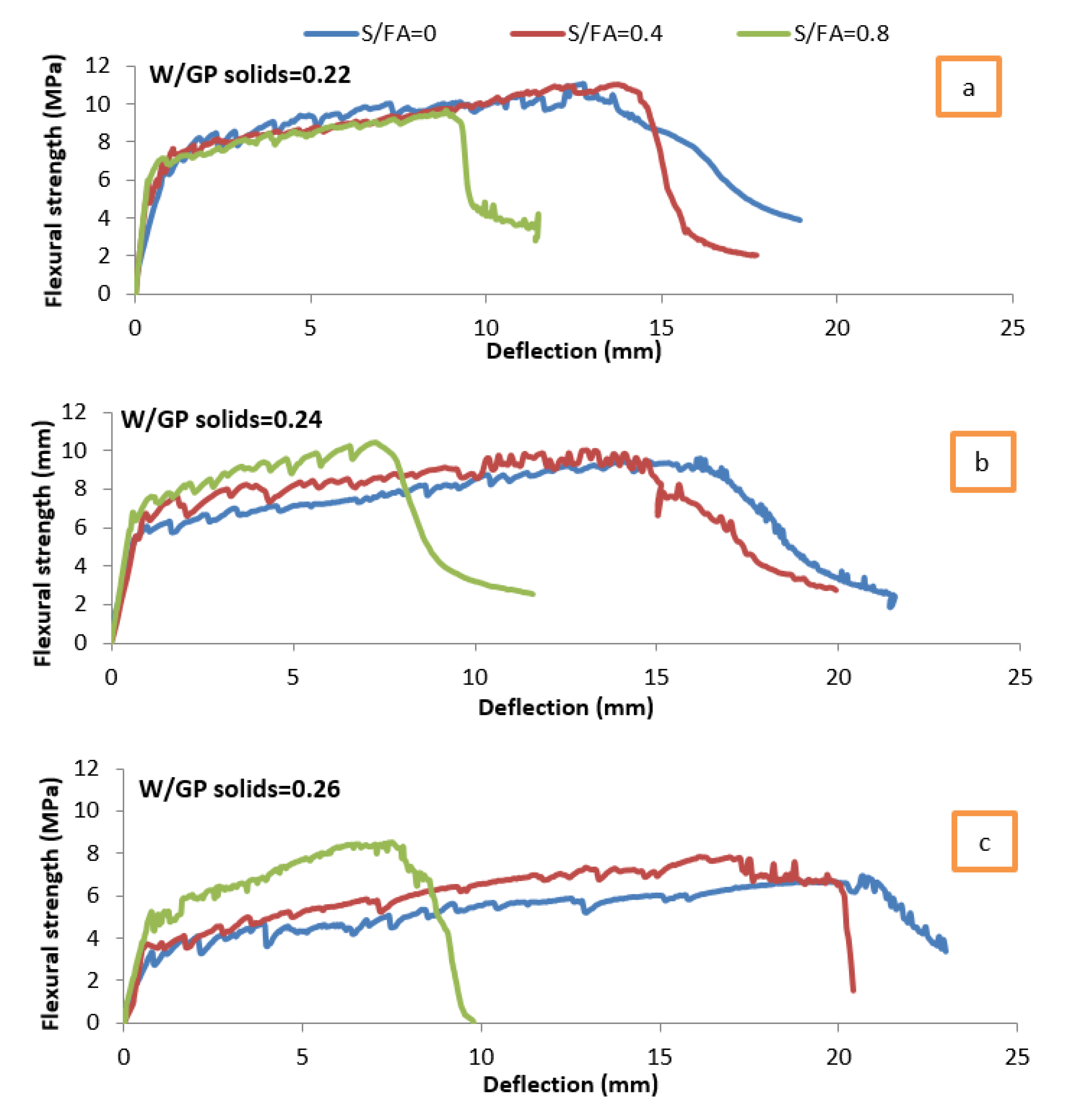
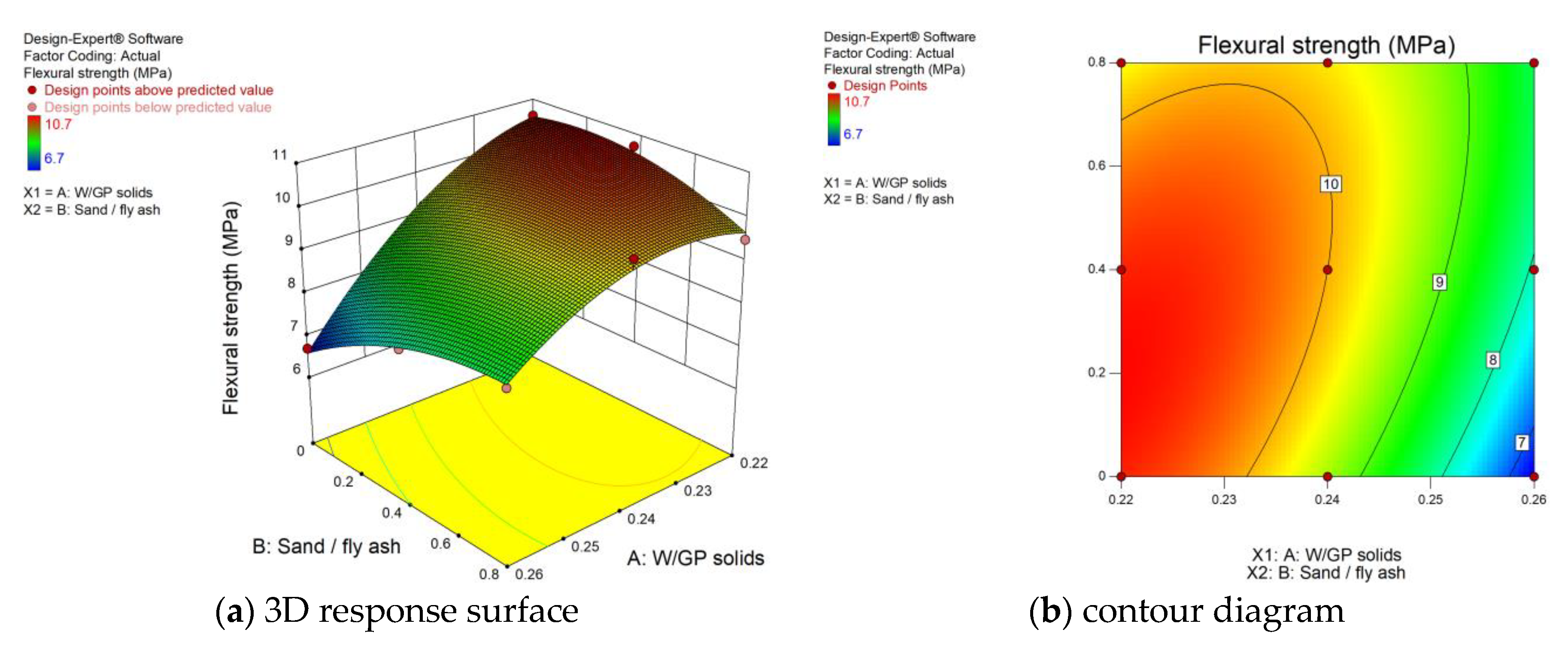

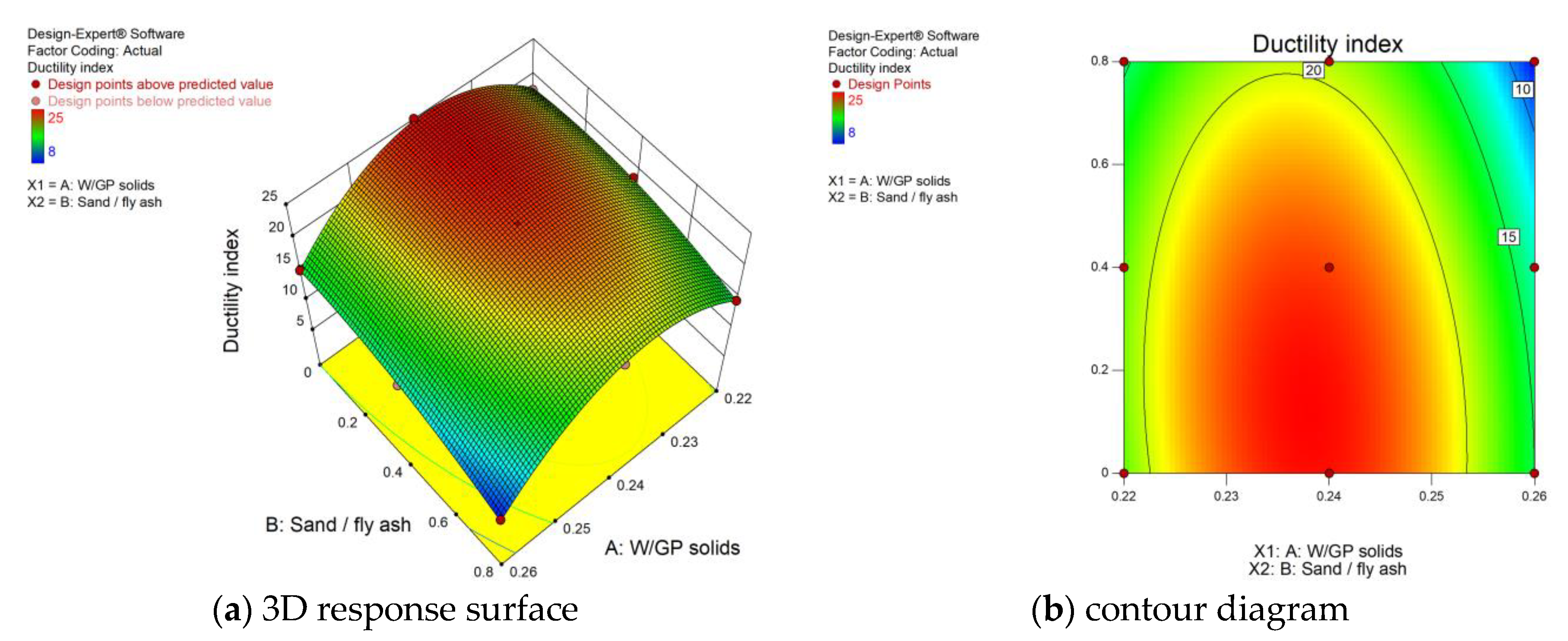
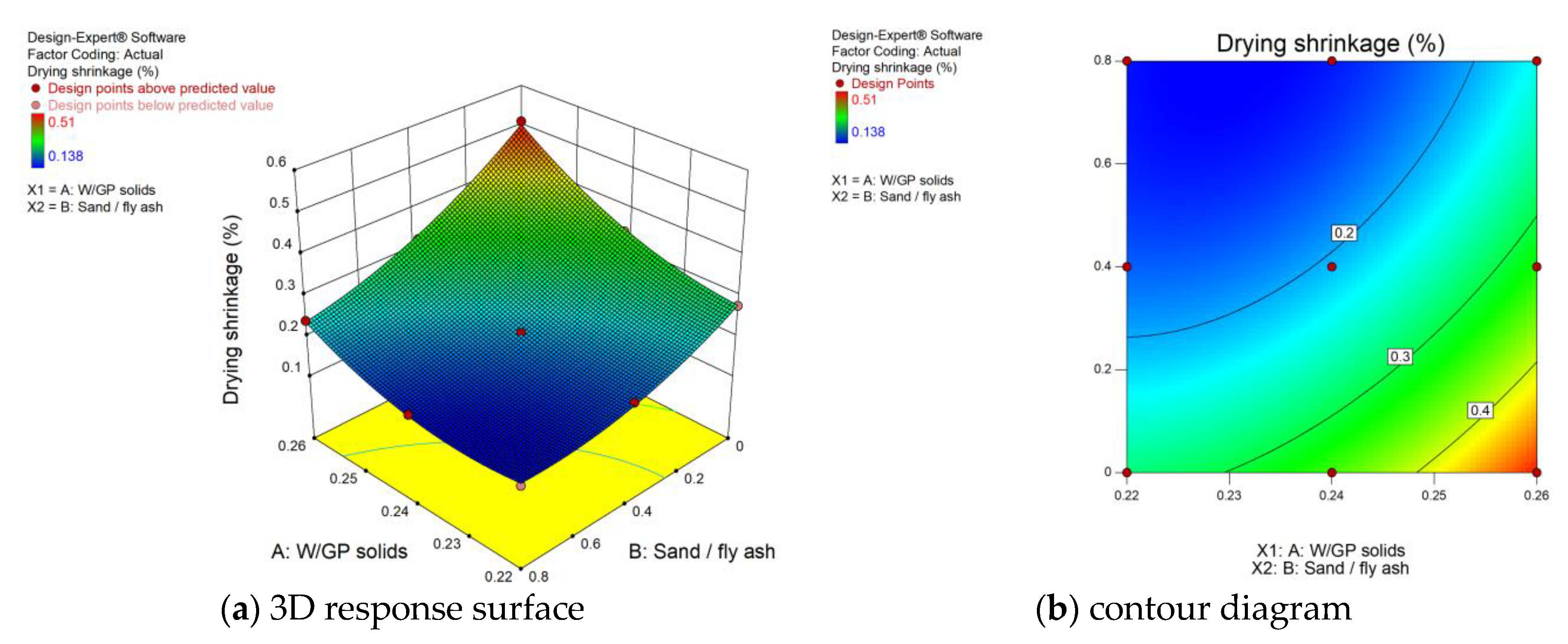


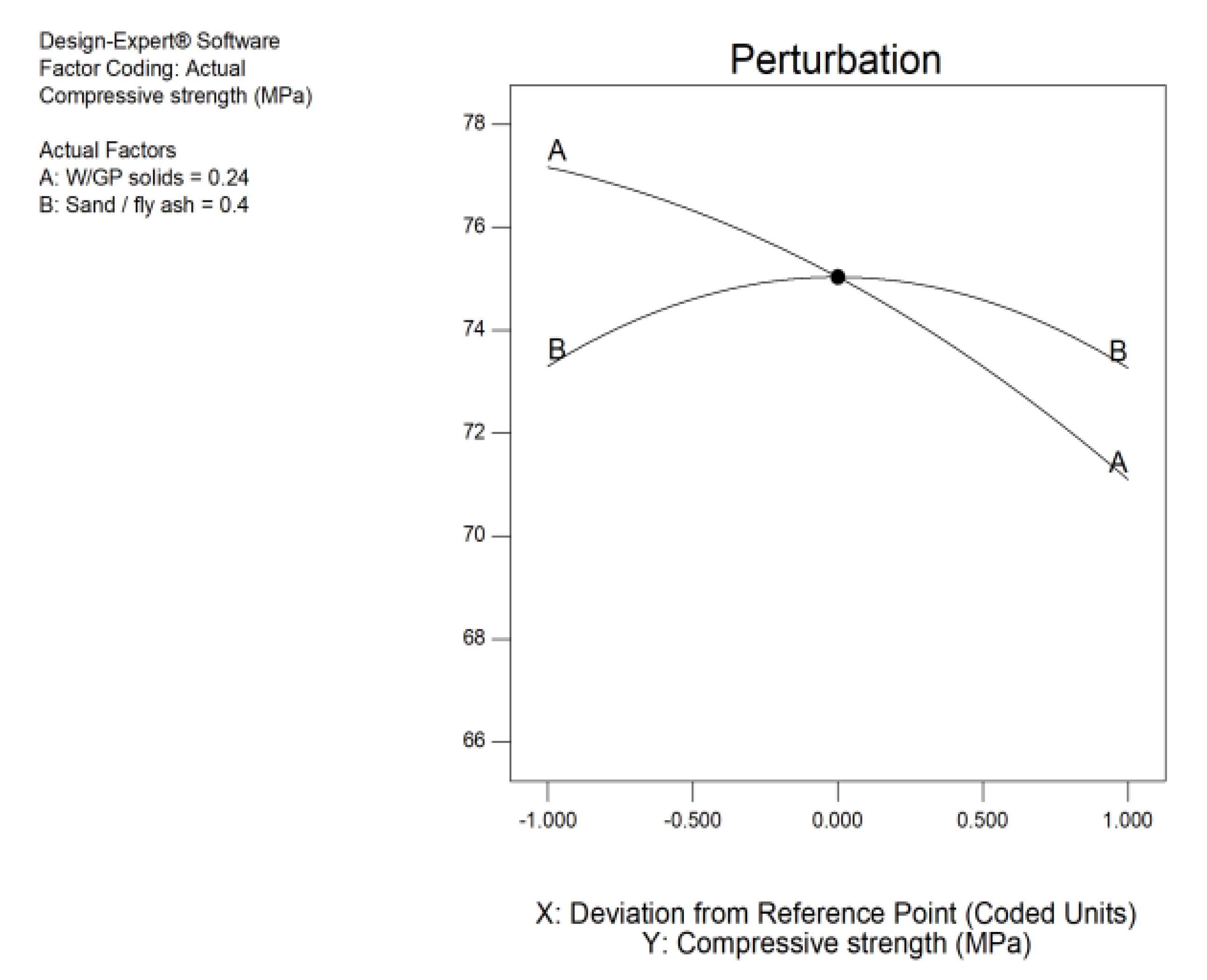
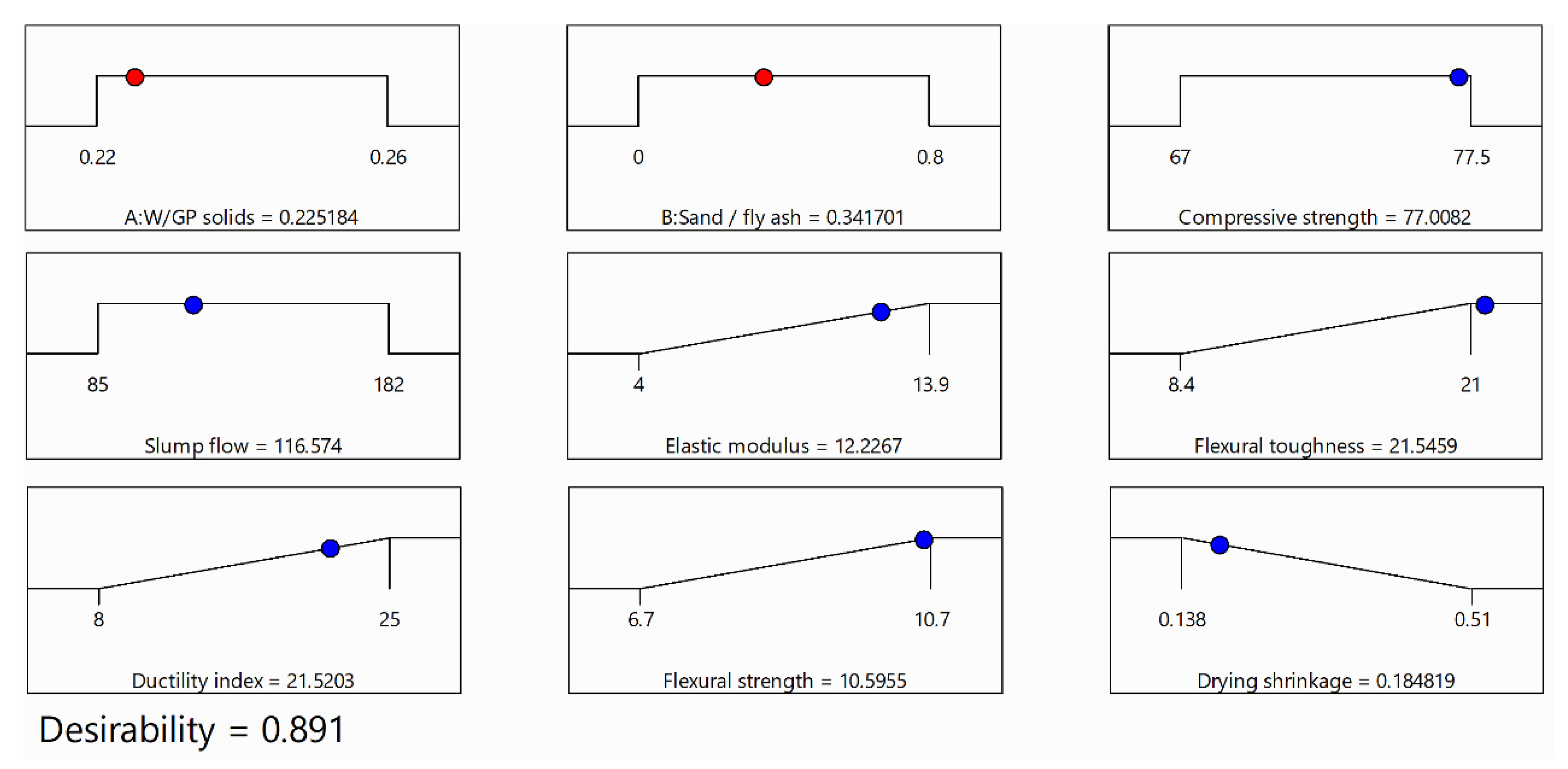



| The Chemical Composition of Fly Ash (%) | ||||||||||
|---|---|---|---|---|---|---|---|---|---|---|
| SiO2 | Al2O3 | Fe2O3 | CaO | MgO | K2O | SO3 | TiO2 | P2O5 | LOI | BET (m2/g) |
| 34.5 | 11.8 | 23.6 | 19.0 | 2.27 | 2.08 | 1.49 | 1.46 | 1.27 | 2.6 | 0.9985 |
| Sieve Size (µm) | 710 | 600 | 300 | 150 |
|---|---|---|---|---|
| Passing (%) | 99.8 | 78.12 | 16.14 | 1.23 |
| Na2SiO3 Solution (%) | 8M NaOH Solution (%) | ||
|---|---|---|---|
| Na2O | 14.7 | NaOH | 26 |
| SiO2 | 29.75 | H2O | 74 |
| H2O | 55.52 | ||
| Brand | Product Code | Length (mm) | Diameter (mm) | Fiber Strength (MPa) | Young’s Modulus (GPa) | Elongation (%) | Density (g/cm3) |
|---|---|---|---|---|---|---|---|
| Kuraray | RECS 15 | 8 | 0.04 | 1600 | 41 | 6 | 1.3 |
| Factor | Code | Levels | ||
|---|---|---|---|---|
| 0 | ||||
| Water/GP solids | X1 | 0.22 | 0.24 | 0.26 |
| sand/fly ash | X2 | 0 | 0.4 | 0.8 |
| Factors | Alkaline Solution a | Extra Water a | Na2SiO3/NaOH | NaOH Molarity (M) | PVA Fiber b | Curing Temperature (°C) | ||
|---|---|---|---|---|---|---|---|---|
| Mix | W/GP Solids | Sand/Fly Ash | ||||||
| M1 | 0.22 | 0 | 0.36 | 0.035 | 2.5 | 8M | 0.02 | 60 |
| M2 | 0.22 | 0.4 | 0.36 | 0.035 | 2.5 | 8M | 0.02 | 60 |
| M3 | 0.22 | 0.8 | 0.36 | 0.035 | 2.5 | 8M | 0.02 | 60 |
| M4 | 0.24 | 0 | 0.36 | 0.058 | 2.5 | 8M | 0.02 | 60 |
| M5 | 0.24 | 0.4 | 0.36 | 0.058 | 2.5 | 8M | 0.02 | 60 |
| M6 | 0.24 | 0.8 | 0.36 | 0.058 | 2.5 | 8M | 0.02 | 60 |
| M7 | 0.26 | 0 | 0.36 | 0.08 | 2.5 | 8M | 0.02 | 60 |
| M8 | 0.26 | 0.4 | 0.36 | 0.08 | 2.5 | 8M | 0.02 | 60 |
| M9 | 0.26 | 0.8 | 0.36 | 0.08 | 2.5 | 8M | 0.02 | 60 |
| Responses (Average EGC Properties; Standard Deviation) | |||||||
|---|---|---|---|---|---|---|---|
| Mix | Compressive Strength (MPa) | Slump Flow (%) | Elastic Modulus (GPa) | Flexural Toughness (N·m) | Ductility Index | Flexural Strength (MPa) | Drying Shrinkage (%) |
| M1 | 77.5; 2.1 | 114; 3.6 | 12.7; 0.6 | 20.1; 0.8 | 18.0; 0.3 | 10.6; 0.4 | 0.28; 0.008 |
| M2 | 77.5; 3.0 | 91; 3.50 | 13.9; 0.4 | 21.0; 0.7 | 18.5; 0.4 | 10.7; 0.4 | 0.18; 0.009 |
| M3 | 73.0; 3.5 | 85; 4.60 | 8.00; 0.2 | 11.7; 0.6 | 14.6; 0.6 | 9.50; 0.3 | 0.14; 0.007 |
| M4 | 73.6; 1.1 | 168; 3.6 | 7.20; 0.2 | 18.6; 0.9 | 25.0; 0.6 | 9.20; 0.2 | 0.34; 0.006 |
| M5 | 75.0; 2.1 | 155; 2.6 | 9.00; 0.2 | 20.1; 0.9 | 23.8; 0.8 | 9.90; 0.4 | 0.21; 0.008 |
| M6 | 73.0; 2.4 | 134; 2.6 | 6.50; 0.1 | 11.2; 0.5 | 19.0; 0.3 | 10.0; 0.3 | 0.15; 0.003 |
| M7 | 67.0; 1.8 | 182; 3.6 | 4.00; 0.1 | 13.2; 0.7 | 15.0;0.7 | 6.70; 0.2 | 0.51; 0.006 |
| M8 | 70.8; 1.9 | 173; 6.1 | 7.00; 0.1 | 15.8; 0.6 | 12.9; 0.1 | 7.90; 0.3 | 0.32; 0.004 |
| M9 | 72.0; 3.5 | 158; 4.4 | 6.00; 0.2 | 8.40; 0.4 | 8.00; 0.3 | 8.30; 0.4 | 0.24; 0.005 |
| Response | Standard Deviation | Mean | R2 | Predicted R2 | Adjusted R2 | Adequate Precision |
|---|---|---|---|---|---|---|
| Slump flow | 2.36 | 136.56 | 0.9988 | 0.9859 | 0.9969 | 63.873 |
| Compressive strength | 0.43 | 73.27 | 0.9937 | 0.9231 | 0.9831 | 31.105 |
| Elastic modulus | 0.61 | 8.26 | 0.9863 | 0.8427 | 0.9634 | 19.166 |
| Flexural strength | 0.22 | 9.20 | 0.9898 | 0.8836 | 0.9729 | 22.255 |
| Flexural toughness | 0.27 | 15.57 | 0.9987 | 0.9841 | 0.9965 | 56.884 |
| Ductility index | 0.38 | 17.21 | 0.9981 | 0.9769 | 0.9949 | 55.144 |
| Drying shrinkage | 0.011 | 0.26 | 0.9969 | 0.9632 | 0.9918 | 41.383 |
| Response | Sum of Squares | Mean Square | F-Value | P-Value Prob > F | Remarks |
|---|---|---|---|---|---|
| Slump flow | 14,431.44 | 2886.29 | 516.09 | 0.0001 | Significant |
| Compressive strength | 85.52 | 17.10 | 94.29 | 0.0017 | Significant |
| Elastic modulus | 80.09 | 16.02 | 43.09 | 0.0054 | Significant |
| Flexural strength | 14.04 | 2.81 | 58.42 | 0.0034 | Significant |
| Flexural toughness | 170.63 | 34.13 | 451.68 | 0.0002 | Significant |
| Ductility index | 225.20 | 45.04 | 315.08 | 0.0003 | Significant |
| Drying shrinkage | 0.11 | 0.022 | 193.65 | 0.0006 | Significant |
| Name of Factors and Response | Goal | Lower Limit | Upper Limit |
|---|---|---|---|
| W/GP solids | In range | 0.22 | 0.26 |
| S/FA | In range | 0 | 0.8 |
| Slump flow | In range | 85 | 182 |
| Compressive strength | Maximize | 67 | 77.5 |
| Elastic modulus | Maximize | 4 | 13.9 |
| Flexural strength | Maximize | 6.7 | 10.7 |
| Flexural toughness | Maximize | 8.4 | 21 |
| Ductility index | Maximize | 8 | 25 |
| Drying shrinkage | Minimize | 0.138 | 0.51 |
| Factors (Variables) | Responses (EGC Properties) | ||||||||
|---|---|---|---|---|---|---|---|---|---|
| W/GP Solids | S/FA | Slump Flow (%) | Compressive Strength (MPa) | Elastic Modulus (GPa) | Flexural Toughness (N·m) | Ductility Index | Flexural Strength (MPa) | Drying Shrinkage (%) | Desirability |
| 0.225184 | 0.341701 | 116.574 | 77.008 | 12.226 | 21.546 | 21.520 | 10.595 | 0.185 | 0.891 |
| Response | Slump Flow (%) | Compressive Strength (Mpa) | Elastic Modulus (Gpa) | Flexural Toughness (N·m) | Ductility Index | Flexural Strength (Mpa) | Drying Shrinkage (%) |
|---|---|---|---|---|---|---|---|
| Predicted | 116.574 | 77.008 | 12.226 | 21.546 | 21.520 | 10.595 | 0.185 |
| Experimental | 121.3 | 80.4 | 11.8 | 22.61 | 20.65 | 11.13 | 0.176 |
| Error (%) | 4.05 | 4.4 | 3.48 | 4.94 | 4.04 | 4.98 | 4.86 |
© 2020 by the authors. Licensee MDPI, Basel, Switzerland. This article is an open access article distributed under the terms and conditions of the Creative Commons Attribution (CC BY) license (http://creativecommons.org/licenses/by/4.0/).
Share and Cite
Zahid, M.; Shafiq, N. Effects of Sand/Fly Ash and the Water/Solid Ratio on the Mechanical Properties of Engineered Geopolymer Composite and Mix Design Optimization. Minerals 2020, 10, 333. https://doi.org/10.3390/min10040333
Zahid M, Shafiq N. Effects of Sand/Fly Ash and the Water/Solid Ratio on the Mechanical Properties of Engineered Geopolymer Composite and Mix Design Optimization. Minerals. 2020; 10(4):333. https://doi.org/10.3390/min10040333
Chicago/Turabian StyleZahid, Muhammad, and Nasir Shafiq. 2020. "Effects of Sand/Fly Ash and the Water/Solid Ratio on the Mechanical Properties of Engineered Geopolymer Composite and Mix Design Optimization" Minerals 10, no. 4: 333. https://doi.org/10.3390/min10040333
APA StyleZahid, M., & Shafiq, N. (2020). Effects of Sand/Fly Ash and the Water/Solid Ratio on the Mechanical Properties of Engineered Geopolymer Composite and Mix Design Optimization. Minerals, 10(4), 333. https://doi.org/10.3390/min10040333






